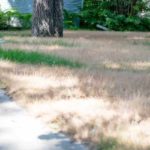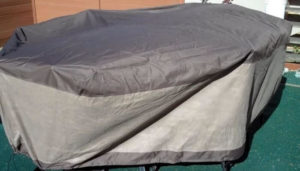It’s one of the worst things that can happen to your lawn. Picture it. You’re outside, enjoying a nice summer day. The breeze is blowing, and you’ve just finished watering some plants. You turn to walk back in and suddenly pain shoots up from your toe. You look down and see wedged between the strap of your sandal or flip flop and your tender flesh – a little ball of spikes the size of a tic-tac.
Grass burrs are the seed pods from a genus of plants known as Cenchrus that grow in sparsely populated, dry, sandy soil. Methods of ridding your yard of this pest weed include using focused herbicides, keeping your yard maintained, and not letting the seeds spread.
No one wants these kinds of plants in their yard, so we need to understand them and do our best to get rid of them. If you want more details on both, just keep reading!

What Are Grass Burrs?
They’re called all kinds of things, some words, I’d get in trouble for repeating! What they are? The seed pods of a specific type of grass, known as Cenchrus echinatus – or southern sandbur. This grass thrives in hot climates and in sandy terrain. That’s why the seed pods and the grass itself are often called sand spurs or sand burrs.
However, there is a huge variety of plants that may have spurs or burrs as part of their seed pod structure and they all belong to the genus Cenchrus. They might also be called stickers or grass stickers. Though most are native to the Americas, they can be found all over the world. I’ve heard spiny sandbur, southern sandbur, and in Australia, it’s called Mossman River Grass.
I was first introduced to them in the summer trips my family and I would take to Dauphin Island, Alabama. The border island had white-sand beaches and if you weren’t wearing flip flops, you just might get a surprise. And we always called them sand spurs. But since we’re discussing this grass as a pest in the backyard, I’m going to refer to it as grass burr.
How Do I Get Rid of Grass Burrs?
The main way to get rid of grass burs is to get into a good lawn maintenance plan. But that takes time, and if you want something that can go ahead and begin getting rid of these invasive plants immediately, you may have to invest in both weed killer and an extreme version of lawn care.
First, be aware that these kinds of grass are very hearty and you may find yourself having to use a very strong weed killer to be rid of it. What I’ve seen suggested are pre-emergent weed killers and maintenance weed killers, usually MSM Turf Herbicide or 2,4-D Amine Selective Weed Killer. Just remember that these herbicides can kill ornamental plants in your landscaping, so be careful.
If you want a natural weed killer (also a cheaper option) that may work on these things, try white vinegar. Just remember that, unlike herbicides, vinegar will also kill all other plants it comes into contact with. So you may be looking at reestablishing your soil and replanting.
You reapply this daily and always remove all burrs or stickers from the area as you handle it.
Be prepared to mow the grass in the infested area twice a week at the least using a bag to trap all clippings. Keep the grass trimmed low to the ground. If you need to reseed after you’ve killed the pest, go for it. Then, water it frequently. This is usually helpful to the plants around the grass burr plant while dissuading any new growth.
How Do I Keep Grass Burrs from Coming Back?
The maintenance of your lawn is the key to keeping grass burrs away once you’ve gotten rid of them. If you have a thick, healthy, well-watered lawn, this is not what grass burrs need. Therefore, they are unlikely to keep growing or coming back to your lawn. You can get help at the Cooperative Extension Service or local Farm Coops.
Know Your Soil
It’s important to get your lawn growing properly if you want to stop giving grass burrs a place to happily grow in your yard. You can test and build up your soil yourself or you can hire a professional company to do it.
Mow with a Bag
Or if you aren’t mowing your own grass, be sure that your lawn care company knows to mow with a bag so that they aren’t spreading the seeds of these little monsters everywhere. If you know where the grass burrs are congregated in your yard, lower the blades or height adjustment on the lawnmower to give even less of a chance that seeds will get spread.
Keep Your Lawn Full of Other Types of Grass or Plants
Grass burrs take over where there is little to no competition. Because it’s such a hearty plant, it doesn’t have an issue growing where other plants refuse to take root. So, the idea is to plant a lot of “wanted” grass or thick ground cover in the area of infestation. That way, the grass burrs will get choked out by the thicker grass.
Keep Your Ground Well Irrigated or Watered Regularly
Grass burr plants are also called “sand burrs” for a reason. They love dry, sandy soil. So, if you mix in good topsoil and keep the ground properly watered, the environment will not be conducive to the grass burr.
In Conclusion
Don’t let this invasive floral pest take over your yard and take away your fun! If you find them anywhere near your yard or you realize you’ve brought some home with you from elsewhere, try to gather all the seed pods you can, and then be aware of the steps above to ensure they don’t get a chance to take hold.













